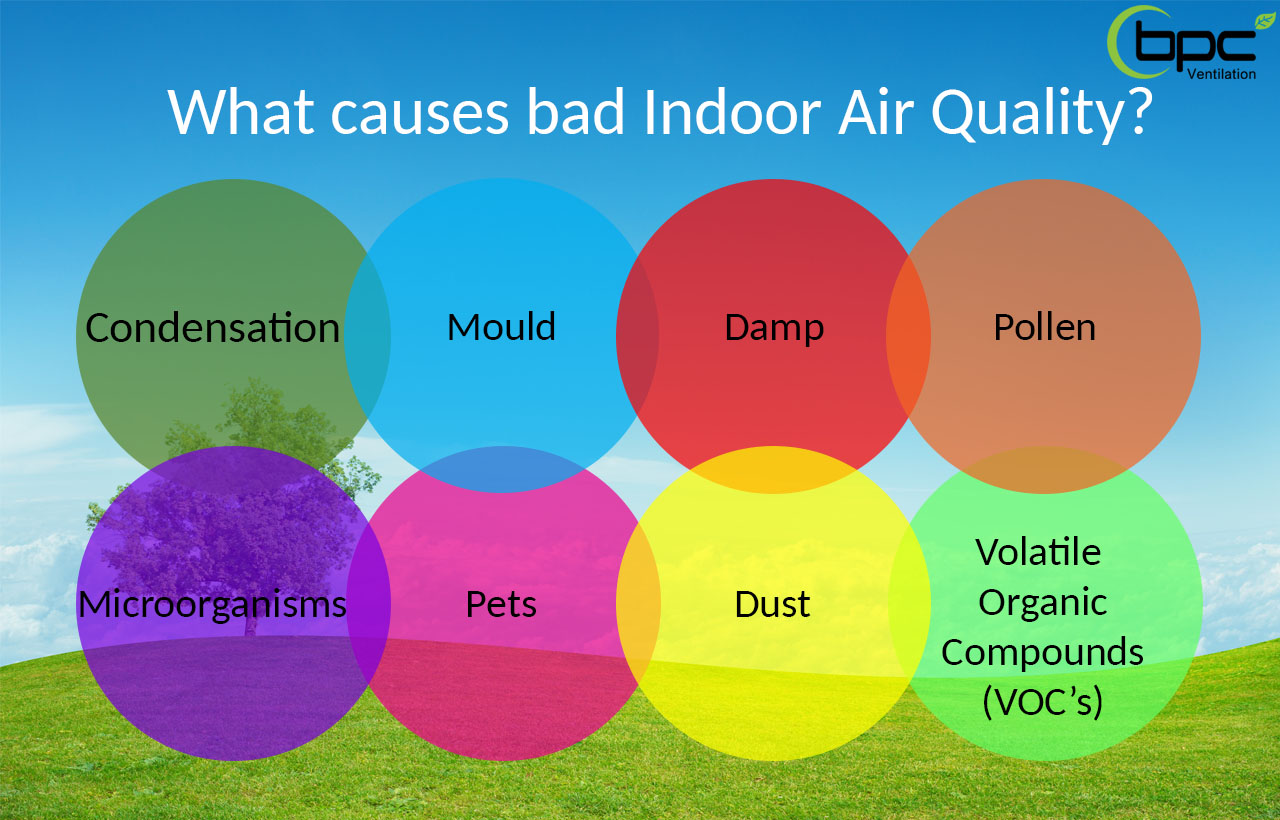What is the Importance of Indoor Air Quality in Educational Buildings?
What is The Importance of Indoor Air Quality in Educational Buildings?
Good Indoor Air Quality (IAQ) has a favourable role in learning environments. The effects of outdoor air pollution are widely known to have negative impacts on our health. However, indoor air quality can be up to 5 times worse than outdoor air.
We are familiar with the impacts of outdoor air pollution on our health, but it is becoming increasingly recognised that indoor air quality (IAQ) can be considerably worse than outdoor air pollution. Optimal thermal comfort and good indoor air quality in school classrooms are essential requirements to promote students’ productivity and reduce risks poor health symptoms.

What is The Importance of Indoor Air Quality in Educational Buildings?
Good Indoor Air Quality (IAQ) has a favourable role in learning environments. The effects of outdoor air pollution are widely known to have negative impacts on our health. However, indoor air quality can be up to 5 times worse than outdoor air.
We are familiar with the impacts of outdoor air pollution on our health, but it is becoming increasingly recognised that indoor air quality (IAQ) can be considerably worse than outdoor air pollution. Optimal thermal comfort and good indoor air quality in school classrooms are essential requirements to promote students’ productivity and reduce risks poor health symptoms.
With new regulations in place that promote new buildings to have good indoor air quality, it is important to consider the IAQ of the UK’s learning environments. Studies show that one half of schools have problems linked to poor IAQ. Pupils are at a greater risk of exposure to poor IAQ because of the hours spent in school facilities and children are often more susceptible to pollutants. The health and comfort of both students and staff are among the many factors that contribute to learning and productivity in the classroom.
"Increasing worries about air quality will mean that mechanical ventilation – with high levels of filtration to remove pollutants – will continue to be the best solution for urban properties close to busy roads"

What are the effects of indoor air pollution?
Over the past 40 years, indoor air pollution has increased due to a variety of factors, including the construction of more air tight buildings combined with the reduction of ventilation. The use of synthetic building materials and using chemically formulated products such as cleaning supplies has also contributed to this rise in poor indoor air quality. Despite educational staff and students spending a considerable amount of time in the confines of school buildings, many people are unaware of the fact that the impact of indoor pollution can be more detrimental to our health than that of outdoor air pollution.
Thermal comfort concerns are closely linked to poor air quality complaints, it is important that temperature and humidity levels are not overlooked. In the Business Bulletin 101 it is only at a thousand parts per million of CO2 levels that begin to make concentration levels of students drop.
“
ventilation should be provided to limit the concentration of carbon dioxide in all teaching and learning spaces so that when it is measured at seated head height, during the continuous period between the start and finish of teaching on any day, the average concentration of CO2 should not exceed 1500 ppm.”– Business Bulletin 101
“
Temperature is also linked with having effects on concentration levels, maintaining a comfortable temperature can help increase productivity which is essential in a learning environment. Therefore, both key factors need to be managed effectively by a well-planned ventilation system.
What are the changes?
The key differences between BB101 2006 and BB101 2018 include a requirement that the average fresh air rate must be at least 5 litres per second per person.
The purge fresh air rate also needs to be 8 litres per second per person for all new build teaching spaces. For natural ventilation systems, CO2 levels should average below 1,500 parts per million (ppm) and for mechanical ventilation systems, CO2 levels should average below 1,000ppm.
The guidelines state that for either system, CO2 levels cannot exceed 1,500ppm for greater than 20 minutes.
The guidelines also set out a major change for refurbished teaching spaces, which now must achieve an average CO2 level of below 1,750ppm.
Indoor Air Quality Problems
Failure to respond effectively to indoor air quality problems, can lead to severe consequences. There could be short term health issues but there is also a risk of more long-term problems for both staff and students. More importantly in an educational setting, poor IAQ frequently leads to lack of concentration and fatigue as mentioned above. Studies show that children in schools who demonstrated shorter attention spans were linked to finding considerable levels of CO2 in the classrooms.
How do I ventilate a building?
In existing buildings, the use of natural ventilation can be more popular to improve indoor air quality because of the perception that it is the most low-cost option for a better indoor air. However, the main problem with natural ventilation is that it’s very dependent on the weather. A building using natural ventilation is allowing cold air and pollutants into a room, which will put further pressure onto the heating system. There is also the difficulty in controlling airflow and the potentially harmful impact that improper ventilation can have on the building’s envelope. The quality of the air coming into the building can also be affected by transport and road construction.
Due to weather conditions not always being favourable towards natural ventilation, mechanical ventilation is a much more reliable option. One of the main benefits that a mechanical ventilation system can offer is that it contains CO2 sensors to control the fans speed depending on the ventilation required. This is especially important in an educational building as high levels of CO2 can cause a lack of concentration and fatigue, and large amount of carbon dioxide can be very serious.
Eliminating Cold Draughts
The need to eliminate cold draughts has also been introduced. These may appear to be of minor importance, but it has been a major problem, particularly in naturally ventilated rooms with teachers closing windows to reduce draughts. This results in much higher CO2 levels which are known to cause drowsiness and lack of attention in students.
Dedicated plant rooms
Additional consideration should also be given to the siting of the central mechanical ventilation equipment. Where a piece of apparatus on a classroom roof was once adequate, colleges may now need to allow for a proper plant room, which will need to be addressed early on within any project design.
Benefits of Heat Recovery in Educational Buildings
There are many benefits of heat recovery, for an educational building these include:
- Lowering Co2 levels
- Providing thermal comfort
- Providing fresh, filtered air into teaching and learning areas
- Extracting stale air
- Recovering heat, creating savings on heating bills
- Reducing risks of indoor pollutants entering buildings
- Controllable air flows
- Filters allowing no pollen or harmful particles to enter rooms
BPC ventilation are specialists in domestic and commercial heat recovery ventilation, check out more benefits of heat recovery.
Mechanical Ventilation Heat Recovery Systems
Although it is not mandatory to have a mechanical ventilation system, they are the most preferred solution and are extremely beneficial in enhancing energy efficiency and reducing the cost of heating bills during winter months. Having good indoor air quality also provides health benefits as well as boosting academic performance. This not only applies to educational buildings but applies to all places of work.
To avoid high levels of CO2 and have a constant supply of fresh healthy air to your home or any building, BPC recommend that the best solution is to install a heat recovery system that will provide fresh, filtered air and recover up to 90% of normally wasted heat. At BPC we stock a wide range of commercial ventilation units, ducting and accessories from leading brands such as Vent Axia, Mitsubishi, Caladair and Quiet-Vent and many more!

Contact Us
BPC Ventilation specialise in heat recovery for any premises from small classrooms to large collage projects. We can design, supply and if required install your system for you!.
For more information on how heat recovery systems work and for more information on our products call our sales and technical team on 028 2827 5150 and we will be happy to help! Alternativity you can visit our website for our range of products.


